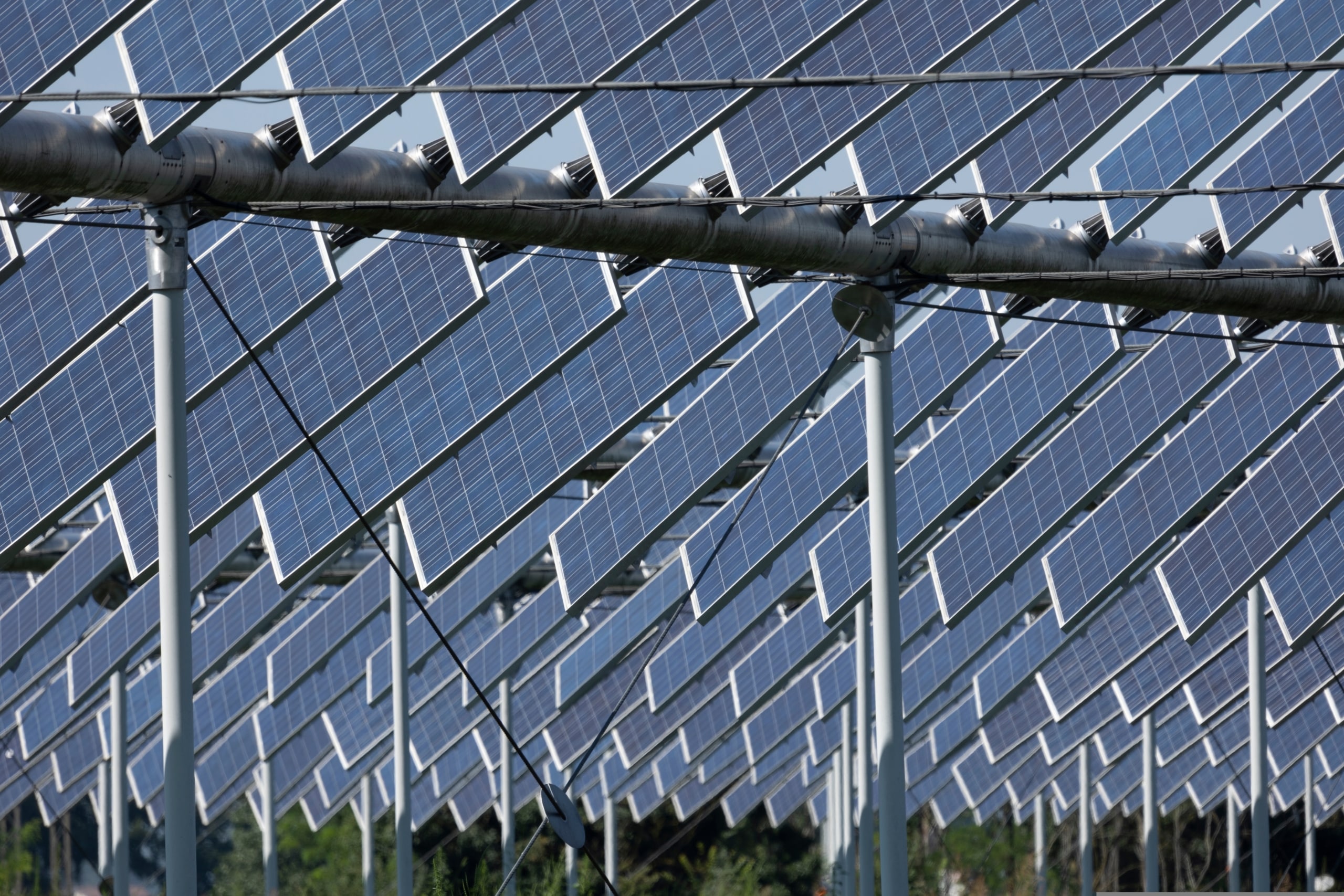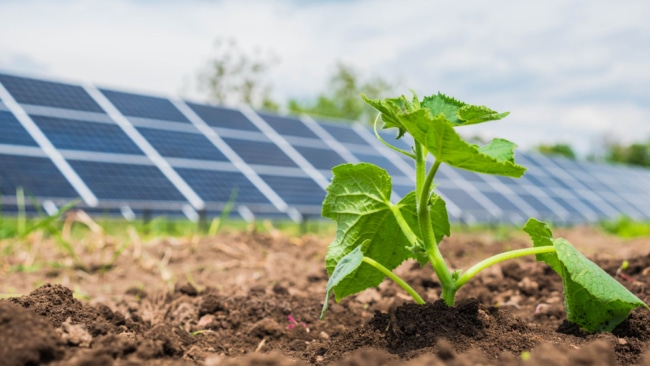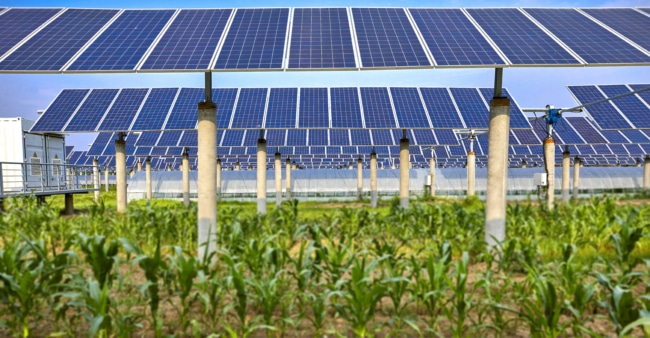What is agrivoltaic farming?

At Venture Steel Group, we're always on the lookout for innovative technologies that not only support sustainable practices but also promise significant long-term benefits. Agrivoltaic farming, a groundbreaking approach that marries agriculture with solar energy production on the same plot of land, has caught our attention for its potential to revolutionise both sectors.
Agrivoltaic systems come in various forms, each designed to optimise land utilisation while simultaneously bolstering crop production and advancing the use of renewable energy. Among these, we find systems where solar panels are elevated above the crops, creating a symbiotic environment where plants thrive under optimised light conditions. Another approach integrates solar panels within greenhouse structures, harnessing solar energy while protecting crops. Additionally, some systems strategically position crops around ground-mounted solar arrays, utilising available land more efficiently.
The integration of these systems presents a plethora of advantages, from enhancing land use efficiency and crop yields to fostering the production of renewable energy. As a forward-thinking company, Venture Steel Group is keen to explore how agrivoltaic farming can contribute to a more sustainable and energy-efficient future, reflecting our commitment to innovation within the renewable energy sector.
What are the different types of Agrivoltaic Farms?
1. Spaced Arrangement
In the spaced arrangement, solar panels are installed in rows above the crops, maintaining a strategic distance between them. This setup ensures that sufficient sunlight reaches the plants below, promoting healthy growth while simultaneously generating clean energy. The dual benefit of this arrangement lies in its ability to maximise land use by combining food and energy production efficiently.
2. Stilted Arrangement
The stilted arrangement involves mounting solar panels on stilts over the agricultural land. This innovative method allows for the versatile use of land beneath the panels. Farmers can grow crops or even graze animals in the shaded area, making it an excellent option for optimising land usage. The elevated structure not only facilitates solar energy production but also minimises land competition, fostering a harmonious coexistence of agriculture and renewable energy generation.
3. Roofed Arrangement
Solar panels in the roofed arrangement are affixed to the roofs of buildings, such as barns or greenhouses. This method serves a dual purpose by providing shelter and acting as a source of solar energy. It is particularly beneficial for agrivoltaic farming practices as it integrates energy generation with the infrastructure already present on the farm, thereby reducing the need for additional land and offering protection to plants or livestock housed within.
Benefits of Agrivoltaic Farming
When considering the benefits of agrivoltaic farming, you'll find that it offers significant advantages such as land optimisation for dual use.
This innovative approach allows for the production of sustainable energy while also providing benefits for plant growth, such as increased shade and protection from extreme weather conditions.
Additionally, agrivoltaic systems can work in harmony with livestock grazing, creating a more integrated and efficient agricultural ecosystem.
- Optimisation of Land Use Maximising land use is paramount in agrivoltaic farming, ensuring both agricultural productivity and solar energy generation reach their full potential. By ingeniously positioning solar panels above crops, we advocate for the efficient utilisation of every square metre of land. This method facilitates the concurrent production of electricity and crops, while also conservatively managing water resources by reducing soil evaporation under the protective shade of solar panels. Moreover, these systems safeguard crops against extreme weather, enhancing yield and bolstering farm resilience against climate variability. Strategic planning and layout are vital to balance solar radiation and rainfall for crops beneath the panels, exemplifying a perfect synergy between energy production and agriculture.
- Contribution to Sustainable Energy Agrivoltaic farming represents a step forward in sustainable energy practices by integrating solar panels with crop production. The dual-use approach not only maximises land efficiency but also contributes to a more sustainable agricultural future. The shading provided by solar panels aids in maintaining soil moisture and cooling crop temperatures during hot spells, fostering a conducive environment for plant growth. By adopting agrivoltaic systems, farmers not only generate clean energy but also enhance crop yields, underscoring our commitment to sustainable innovation.
- Advantages for Plant Growth Venture Steel Group recognises the invaluable benefits of controlled shade provided by solar panels, which contribute significantly to creating an optimal growth environment for plants. The moderated microclimate reduces plant stress and conserves water more effectively, while the diffused sunlight ensures even photosynthesis, leading to healthier plant development. Agrivoltaic farming thus emerges as a guardian of plant well-being, ensuring their growth is nurtured under ideal conditions.
- Integration with Livestock: Agrivoltaic systems unlock a unique synergy between solar panel installations and livestock grazing, improving land productivity and animal welfare. The shade from solar panels provides livestock with a protective sanctuary against heat and harsh weather, this is why we make Sheep Guards to ensure the animals' safety around solar installations. This integration demonstrates Venture Steel Group's commitment to a sustainable, efficient agricultural future by optimising land use and combining renewable energy with agricultural practices.

How can agrivoltaic farming tackle climate change
Agrivoltaic farming emerges as a forward-thinking solution to combat climate change by harmonising solar energy production with agricultural operations, underlining a pathway to sustainability. By embedding solar panels within farmlands, this innovative practice diminishes greenhouse gas emissions and curtails reliance on fossil fuels, marking a stride towards a greener future.
1. Climate Change Mitigation
Integrating solar panels into agricultural landscapes not only boosts renewable energy uptake but also significantly cuts greenhouse gas outputs. This dual-functionality approach signifies a strategic leap in mitigating climate change impacts.
2. Enhanced Crop Protection:
The canopy formed by solar panels shields crops from the harshness of extreme weather, thereby reducing evapotranspiration and conserving vital soil moisture. This protective measure not only increases agricultural productivity but also aids in preventing desertification and encourages restoration of vegetation.
3. Water Conservation Benefits:
The shade provided by solar panels plays a crucial role in water conservation, with savings ranging from 14–29% attributable to reduced evaporation. This considerable reduction in water use underscores the efficiency of agrivoltaic systems in managing precious water resources.

Where is Agrivoltaic farming used today?
Across farms in America and Europe, there's a growing trend of blending solar panels with agricultural land to produce renewable energy while also making the most of the land. A standout example is a soybean farm in northeast France, which has set up 5,000 PV panels in a raised arrangement. This clever setup allows heavy machinery to operate underneath without any interference from the panels above. This method, called agrivoltaic farming, enables farmers to harvest clean electricity and grow crops on the same piece of land.
Moreover, agrivoltaic farming plays a crucial role in tackling climate change by cutting down carbon emissions and fostering sustainable practices within the agricultural sector. Its appeal is spreading worldwide, driven by the dual advantages of boosting renewable energy output and maximising land use for both agriculture and solar power generation.
What are the Benefits and incentives for farmers
Farmers stand to gain significantly from integrating solar panels with their agricultural operations. By adopting agrivoltaic farming practices, they can tap into solar energy to produce electricity while also shading their crops. This innovative approach doesn't just lower water consumption by enabling more efficient irrigation; it also provides farmers with a means to reduce energy expenses through the generation of their own renewable energy.
Moreover, the financial appeal of agrivoltaic systems is enhanced by various government incentives, including tax credits and grants, designed to motivate farmers towards this sustainable solution. Taken together, the economic and environmental benefits make agrivoltaic farming an attractive, sustainable, and cost-effective strategy for contemporary agriculture.

How can agrivoltaic farming be utilised in the UK?
Agrivoltaic farming could be a game-changer for the UK, blending the need for renewable energy with the age-old practice of farming. In the UK, where land is precious and the weather can be a farmer's biggest challenge, using solar panels to both generate clean energy and protect crops makes perfect sense. The UK's often overcast and rainy climate might not seem ideal for solar power at first glance, but solar panels can still capture sunlight even on cloudy days, even in below-freezing weather, solar panels turn sunlight into electricity. That's because solar panels absorb energy from our sun's abundant light, not the sun's heat. In fact, cold climates are actually optimal for solar panel efficiency. This means that agrivoltaic systems in the UK could consistently generate electricity while offering crops protection from too much rain or the occasional drought. The shade from the panels can keep the soil moist longer, which is great for crops during dry periods.
On the financial side, the UK government already encourages green energy and sustainable farming through various schemes. If more incentives were specifically tailored for agrivoltaic systems, it would make it financially attractive for farmers to jump on board. This could significantly lower the startup costs associated with installing solar panels. Plus, generating their own power could help farmers save on energy bills in the long run. Integrating solar power into farming could also contribute significantly to the UK's renewable energy goals and its commitment to reducing carbon emissions. Essentially, agrivoltaic farming in the UK is not just about adapting to climate change; it's about moving forward in a way that's better for the planet and can still keep our farms running efficiently.
Conclusion
In conclusion, agrivoltaic farming emerges as a beacon of hope in the battle against climate change, ingeniously merging the realms of agriculture and solar energy production. By capitalising on the dual use of land, farmers not only open up new avenues for revenue but also play a pivotal role in slashing greenhouse gas emissions. This approach lays the groundwork for creating resilient food and energy systems, presenting an avant-garde strategy to tackle environmental challenges head-on.
As the adoption of agrivoltaic farming accelerates globally, its potential to pave the way for a greener, more sustainable future becomes increasingly apparent. This practice not only aligns with the urgent need for environmental stewardship but also demonstrates a viable path forward in harmonising agricultural productivity with renewable energy generation. Hence, agrivoltaic farming stands out as a promising endeavour for securing a sustainable and prosperous future for all.